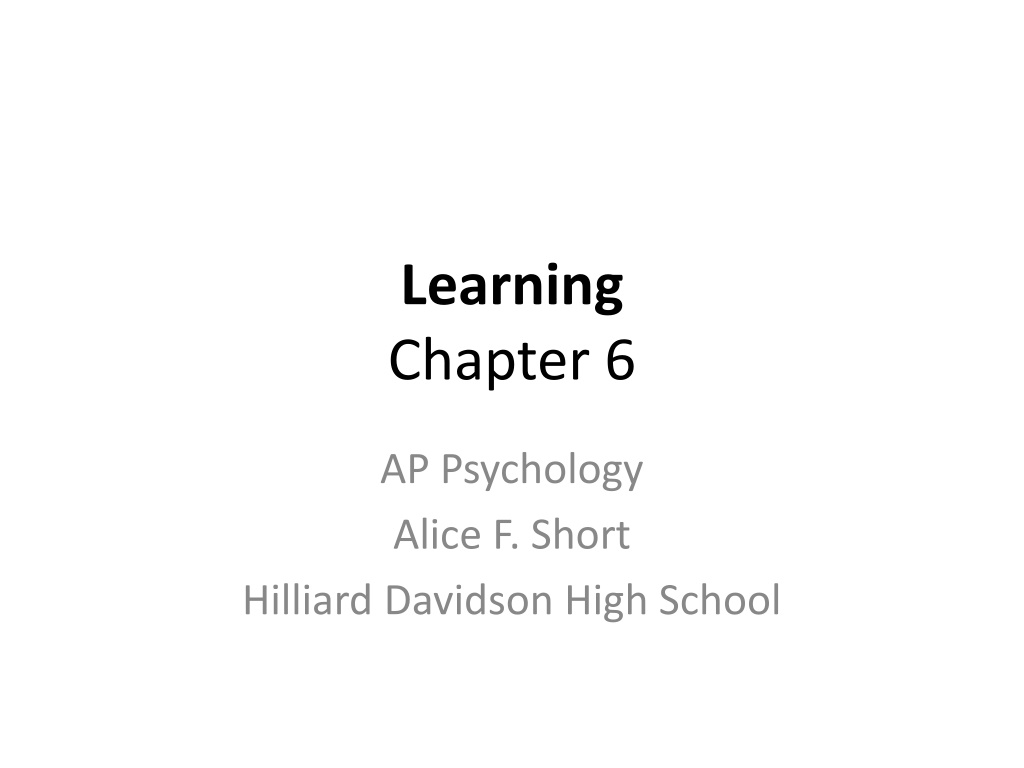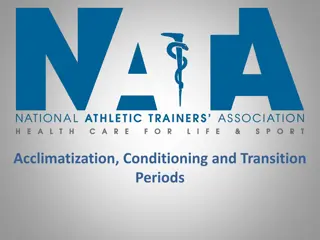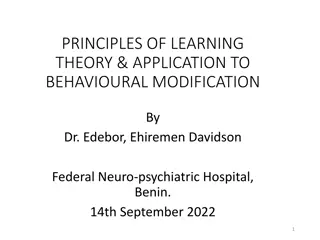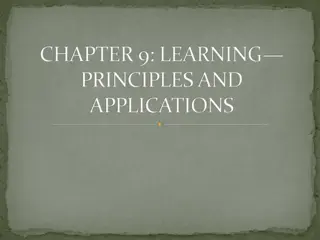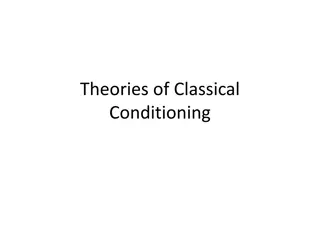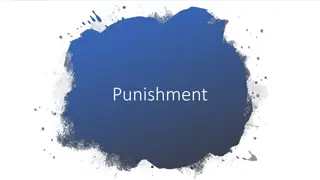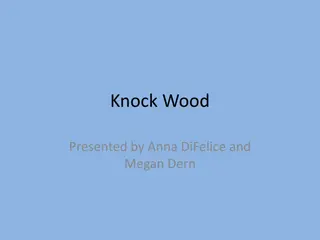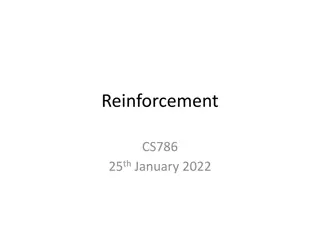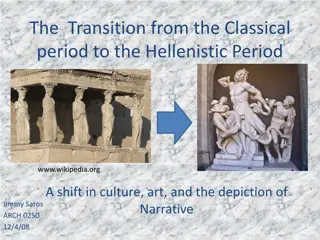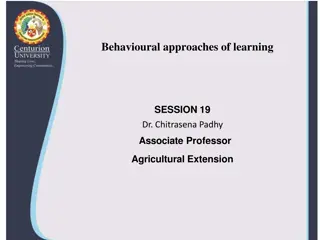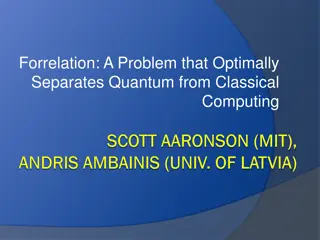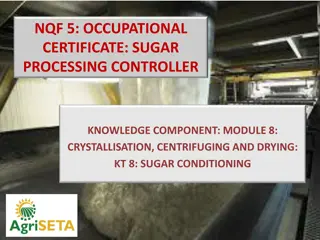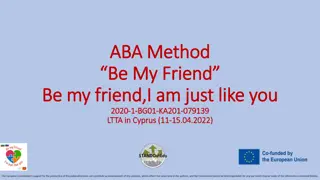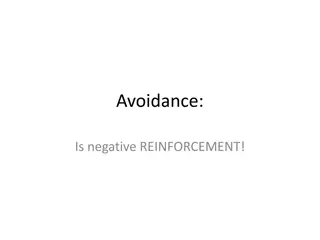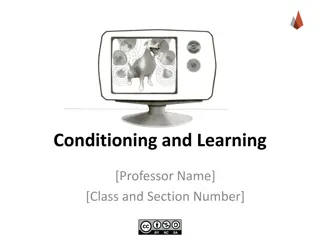Basics of Learning: Classical and Operant Conditioning Overview
Types of learning include classical conditioning, operant conditioning, and observational learning. Classical conditioning involves pairing a neutral stimulus with a meaningful one to elicit a response. Operant conditioning focuses on how consequences influence behavior. Terminology like UCS, UCR, NS, CS, and CR are used to explain classical conditioning. Pavlov's work exemplifies classical conditioning principles.
Download Presentation

Please find below an Image/Link to download the presentation.
The content on the website is provided AS IS for your information and personal use only. It may not be sold, licensed, or shared on other websites without obtaining consent from the author. Download presentation by click this link. If you encounter any issues during the download, it is possible that the publisher has removed the file from their server.
E N D
Presentation Transcript
Learning Chapter 6 AP Psychology Alice F. Short Hilliard Davidson High School
Chapter Preview Classical Conditioning Operant Conditioning Observational Learning Factors That Affect Learning Learning and Health and Wellness
Types of Learning learning - a systematic, relatively permanent change in behavior that occurs through experience behaviorism a theory of learning that focuses solely on observable behaviors, discounting the importance of such mental activity as thinking, wishing, and hoping associative learning / conditioning learning that occurs when we make a connection, or an association, between two events observational learning learning that occurs when a person observes and imitates another s behavior
Types of Associative Learning classical conditioning learning process in which a neutral stimulus becomes associated with a meaningful stimulus and acquires the capacity to elicit a similar response operant conditioning (a.k.a. instrumental conditioning) a form of associative learning in which the consequences of behavior change the probability of the behavior s occurrence operant references behavior of the ORGANISM
Classical Conditioning: Terminology helps to explain involuntary behavior unconditioned stimulus (UCS) unconditioned response (UCR) neutral stimulus (NS) conditioned stimulus (CS) conditioned response (CR)
Classical Conditioning: Terminology unconditioned stimulus (UCS) a stimulus that produces a response without prior learning unconditioned response (UCR) an unlearned reaction that is automatically elicited by the unconditioned stimulus neutral stimulus (NS) a stimulus that does not elicit an unconditioned response conditioned stimulus (CS) a previously neutral stimulus that eventually elicits a conditioned response after being paired with the unconditioned stimulus conditioned response (CR) the learned response to the conditioned stimulus that occurs after conditioned stimulus-unconditioned stimulus pairing reflex an automatic stimulus-response (S-R) connection
Activity Handout 6.1 Identify the UCS, CS, UCR and CR Read through the examples below and then identify the UCS, CS, UCR, and CR in each of the examples. Pamela is walking her child at the mall and a lady walks by and stops to see the baby. The lady has a shiny, noisy bangle of bracelets that are the same as the ones Pamela wears. When the lady reaches down to pat the baby on the head, the bangles make noise and the baby starts making suckling noises. UCSfood (milk) CS the noise from the bracelets UCRsuckling noises CR suckling noises
Activity Handout 6.1 Identify the UCS, CS, UCR and CR Read through the examples below and then identify the UCS, CS, UCR, and CR in each of the examples. Scott s dog waits every afternoon in the front room for Scott to come home. He knows when he hears the garage door open, Scott will come in and take him out for a walk. One evening Scott leaves to go get something at the grocery store. As he is leaving, he hits the garage door opener and the dog starts running around like crazy. UCSgoing on a walk CS garage door UCRdog s excitement CR dog s excitement
Activity Handout 6.1 Identify the UCS, CS, UCR and CR Read through the examples below and then identify the UCS, CS, UCR, and CR in each of the examples. Elmer really likes to cook with onions and he puts onions into almost everything he makes. He usually starts dinner every day around 5:00 p.m. As he is cutting the onions, the grandfather clock chimes five times because it is 5:00 p.m. Elmer is also crying because cutting the onions makes his eyes water. One evening he is at a friend s house because they are going out to dinner later. He and his friend are watching TV and the clock chimes five times when it is 5:00 p.m. Elmer s eyes start to water. UCS onions CS UCR crying CR clock chiming five times crying
Classical Conditioning: Procedure acquisition UCS produces a UCR (reflex) neutral stimulus (NS) paired with a UCS after pairings, NS produces a CR the NS has become a CS contiguity time between CS and UCS contingency is CS regularly followed by the UCS?
Classical Conditioning: Pavlov Unlearned/Reflexive UCS meat powder UCR dog salivates NS sound of Pavlov s bell (prior to pairings with meat powder) Learned CS sound of Pavlov s bell CR dog salivates
Classical Conditioning Generalization CRs may appear after various NS that are similar to the CS Discrimination CRs appear after the CS but not after other CSs discrimination generally learned by presenting other CSs without the UCS
Classical Conditioning Extinction CR is weakened by presenting the CS without the UCS Pavlov rang the bell but did not present food, and the dog stopped salivating Spontaneous Recovery CR recurs after a time delay and without additional learning when Pavlov rang the bell the next day, the dog salivated Renewal recovery of the CR when organism is placed in novel context
Classical Conditioning classical conditioning -
Classical Conditioning: Applications Phobias Watson and Rayner (1920) Little Albert white rat (CS) paired with loud noise (UCS) fear of rat (CR), fear of loud noise (UCR) fear of other animals (generalization) Counterconditioning associate CS with new, incompatible CR CS paired with new UCS aversive conditioning a form of treatment that consists of repeated pairings of a stimulus with a very unpleasant stimulus antabuse a drug treatment for alcoholism since 1940s
Classical Conditioning: Applications placebo effect the effect of a substance or procedure (such as taking a pill) that is used as a control to identify the actual effects of a treatment (example: drop in pain) immune (disease) and endocrine (hormones) responses immunosuppression a decrease in the production of antibodies, which can lower a person s ability to fight disease sympathetic nervous system (part of autonomic nervous system that responds to stress) taste aversion between taste and nausea unique (only 1 pairing required) advertising associative learning drug habituation decreased responsiveness to a stimulus after repeated presentation preparing body braces self
A SHORT Time to Ponder How might parents and schools accidently condition undesirable behaviors? Relate this to immunosuppression. Could you condition yourself to eat healthy? How? What routines do you have that might be triggering unconscious conditioned responses? Think habituation and preparing.
A SHORT Activity With a partner or group of three, create a table or diagram in your spiral to explain the placebo effect using classical conditioning terminology. With the same partner or group of three, create a table or diagram in your spiral to explain the advertising of a specific product using classical conditioning terminology.
Operant Conditioning operant conditioning (a.k.a. a form of associative learning in which the consequences of a behavior change the probability of the behavior s occurrence operant references behavior of the organism better explains voluntary behaviors the consequences of a behavior change the probability of that behavior s occurrence
Operant Conditioning Thorndike s Law of Effect consequence strengthens or weakens a S R connection behaviors (reactions) followed by positive outcomes are strengthened behaviors (reactions) followed by negative outcomes are weakened not technically operant conditioning trial and accidental success B.F. Skinner expanded on Thorndike s work named operant conditioning maintained that his research with pigeons demonstrated the usefulness of operant conditioning techniques for behavior control shaping (reward approximations of the desired behavior) You have permission to be as smart as a seeing eye dog. - Mr. Hickey
Activity Handout 6.2 How Do You Shape This Behavior? Look over the list of behaviors below and choose three of the behaviors. Explain how you would go about (what steps you would use) shaping each of the behaviors you chose. Riding a bicycle Jumping rope Brushing your teeth Making cookies Potty training Getting someone to complete their homework Each example should include: the concept of beginning the training by rewarding any approximation of the behavior then gradually only rewarding the actual behavior.
http://www.uiowa.edu/~c169070/outlines/images/06skinner.jpg B.F. Skinner I did not direct my life. I didn't design it. I never made decisions. Things always came up and made them for me. That's what life is. Give me a child and I'll shape him into anything. The consequences of an act affect the probability of its occurring again. The real problem is not whether machines think but whether men do. Society attacks early, when the individual is helpless. http://clzimages.com/book/large/05/05_679296_0_BFSkinner_AboutBehaviorism.jpg
Skinner Box http://www.simplypsychology.org/skinner%20box.jpg
Skinner Box (1930s) Developed by B. F. Skinner, a Skinner box is a chamber that contains a bar or key that an animal can press or manipulate in order to obtain food or water as a type of reinforcement. recorded each response provided by the animal recorded unique schedule of reinforcement that the animal was assigned design of Skinner boxes varied depending upon the type of animal and the experimental variables. chamber that includes at least one lever, bar, or key that the animal can manipulate lever is pressed, food, water, or some other type of reinforcement might be dispensed Other stimuli can also be presented including lights, sounds, and images. In some instances, the floor of the chamber may be electrified. purpose of a Skinner box -could carefully study behavior in a very controlled environment. Example determine which schedule of reinforcement led to the highest rate of response in the study subjects
B.F. Skinner 4 Ways to Shape Behavior 1. positive reinforcement 2. negative reinforcement 3. positive punishment 4. negative punishment
Operant Conditioning: Reinforcement reinforcement the process by which a rewarding stimulus or event (a reinforcer) following a particular behavior increases the probability that the behavior will happen again Reinforcement increases behavior. positive reinforcement increases behavior negative reinforcement increases behavior Positive Reinforcement behavior followed by rewarding consequence rewarding stimulus is added example: telling joke listener laughing Negative Reinforcement behavior followed by rewarding consequence aversive (unpleasant) stimulus is removed example: putting on gloves cold gone
Operant Conditioning: Reinforcement positive reinforcement increases behavior negative reinforcement increases behavior
Principles of Reinforcement: Avoidance Reinforcement Avoidance Reinforcement (a.k.a. avoidance learning) an organism's learning that it can altogether avoid a negative stimulus by making a particular response by making a particular response, a negative stimulus can be avoided Example: previously failed test studying a lot in the future avoid future failing grades NOTE: changing behavior permanently
Principles of Reinforcement: Learned Helplessness Learned Helplessness - an organism s learning through experience with unavoidable negative stimuli that it has no control over negative outcomes an organism learns it has no control over negative outcomes Example: student fails in school whether studies or not student gives up on studying if student studied now would be successful (different class, gained additional skills, etc.) but continues to give up on trying
2 Types of Reinforcers Primary Reinforcers innately satisfying pleasurable w/o learning examples: food, water, sexual satisfaction Secondary Reinforcers learned / conditioned reinforcer become satisfying through experience (learning) repeated association with a pre-existing reinforcer token economy behaviors are rewarded with tokens (such as poker chips or stars on a chart) that can be exchanged later for desired rewards (such as candy or money) examples: grades, paychecks
A SHORT Time to Ponder How is caring about grades unnatural? Thinking about reinforcers, how could we improve public education? How could you improve YOUR education / learning experience?
Schedules of Reinforcement Generalization (in operant conditioning) performing a reinforced behavior in a different situation stimulus sets the occasion for the response responding occurs to similar stimuli Discrimination (in operant conditioning) responding appropriately to stimuli that signal that a behavior will or will not be reinforced stimuli signal when behavior will or will not be reinforced Extinction (in operant conditioning) behavior decreases when reinforcement stops Spontaneous Recovery
Schedules of Reinforcement schedule of reinforcement specific patterns that determine when a behavior will be reinforced Continuous Reinforcement Partial Reinforcement (vocabulary) fixed set variable not set / unpredictable ratio # interval time
4 Schedules of Partial Reinforcement Fixed Ratio (FR) reinforcement follows a set # of behaviors not used in casinos (problem / beat system) Variable Ratio (VR) reinforcement follows an unpredictable # of behaviors (e.g., an average) used in casinos: consistent, but not predictable resistant to extinction Fixed Interval (FI) reinforcement follows behavior that occurs after a set amount of time has elapsed behavior increases before anticipated event example: elections Variable Interval (VI) reinforcement follows behavior that occurs after an unpredictable amount of time has elapsed example: pop quizzes
A SHORT Time to Ponder According to the textbook, pop quizzes are considered to be variable interval. How could you argue that it is variable ratio? ON A TEST Please put variable interval!
Schedules of Reinforcement
Punishment punishment decreases behavior. Positive Punishment behavior followed by aversive consequence aversive (unpleasant) stimulus is added Negative Punishment behavior followed by aversive consequence rewarding stimulus is removed example: timeout; jail (freedom removed)
Punishment punishment a consequence that decreases the likelihood that a behavior will occur
Activity Handout 6.3 Which Schedule Is It? For each of the scenarios below, determine which schedule is being used such as positive reinforcement, negative reinforcement, positive punishment, and negative punishment. Explain why you chose your answer. Libby gets twenty dollars for every A she brings home on her report card. Schedule: positive reinforcement For every A that Tim gets on his report card he doesn t have to do his chores for two days. Schedule: negative reinforcement Every time the dog rolls over he gets a doggy treat. Schedule: positive reinforcement Jim comes home way after curfew and his parents take his car keys away for a week. Schedule: negative punishment Sally talks back to her mom and she gets grounded for three weeks. Schedule: negative punishment
Controversy Over Punishment p. 192 corporal punishment used by 70-90% of parents in the U.S. correlational research studies problems associated with punishment why should parents avoid spanking? is physical punishment necessary?
Operant Conditioning: Timing of Consequences Timing of Consequences immediate versus delayed reinforcement immediate versus delayed punishment immediate versus delayed reinforcement and punishment obesity; smoking; drinking
Operant Conditioning: Applied Behavior Analysis Applied Behavior Analysis behavior modification work and school performance training autistic children to instruct individuals on effective parenting to enhance environmentally conscious behaviors (recycling, not littering) to promote workplace safety to improve self control
Activity Handout 6.4 How Do You Change the Behavior? Read over the negative behaviors listed below. Choose three of the behaviors and explain how you would go about changing that behavior into a more positive behavior. Use the steps of behavior modification that were discussed in the chapter. Talking back to your parents Getting bad grades in school Taking toys on the playground that do not belong to you Kicking and hitting your sister Writing on the table with crayons while coloring Splashing water all over the bathroom floor while taking a bath Using your mother s lipstick to draw pictures on the walls Answers should include the following steps: 1. define the problem 2. commit to change 3. collect information about yourself 4. design a self-control program including self-talk, self-instruction, or self- reinforcement 5. maintenance: establish follow-up checks and plans for when progress is not maintained
Observational Learning learning that occurs when a person observes and imitates behavior (modeling) Albert Bandura Social Cognitive Theory four processes attention retention motor reproduction reinforcement vicarious reinforcement vicarious punishment
Observational Learning: Bandura s Model of Observational Learning observational learning learning that occurs when a person observes and imitates another s behavior
Albert Bandura and Bobo Clowns, which are creepy http://4.bp.blogspot.com/-lgdcVBBxVIA/UF38zWAoKlI/AAAAAAAAABg/kVmAzhzRBSs/s320/bobo+doll+2.jpg Bobo doll experiment (1961, 63) - experiments conducted by Albert Bandura studying children's behavior after watching an adult model act aggressively towards a Bobo doll There are different variations measured the children's behavior after seeing the model get rewarded, punished or experience no consequence for beating up the bobo doll empirical demonstration of Bandura's social learning theory It shows that people not only learn by being rewarded or punished itself (behaviorism), they can learn from watching somebody being rewarded or punished, too (observational learning) important because they sparked many more studies on the effects of observational learning practical implication, e.g. how children can be influenced watching violent media http://news.stanford.edu/news/2007/december5/gifs/graw_bandura.jpg
